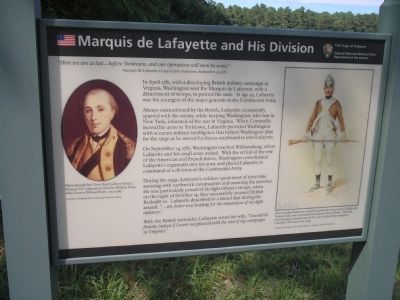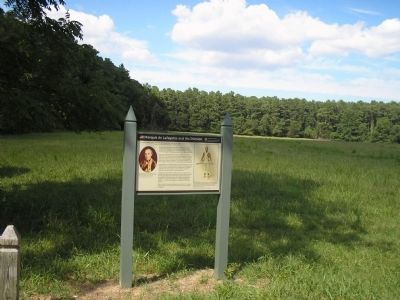Yorktown in York County, Virginia — The American South (Mid-Atlantic)
Marquis de Lafayette and His Division
1781 Siege of Yorktown
— Colonial National Historical Park —
“Here we are at last … before Yorktown, and our operations will soon be noisy.”
Marquis de Lafayette, Camp before Yorktown, September 30, 1781
In April 1781, with a developing British military campaign in Virginia, Washington sent the Marquis de Lafayette, with a detachment of troops, to protect the state. At age 23, Lafayette was the youngest of the major generals in the Continental Army.
Always outnumbered by the British, Lafayette occasionally sparred with the enemy, while keeping Washington, who was in New York, informed of the war in Virginia. When Cornwallis moved his army to Yorktown, Lafayette provided Washington with accurate military intelligence that helped Washington plan for the siege as he moved his forces southward to join Lafayette.
On September 14, 1781, Washington reached Williamsburg, where Lafayette and his small army waited. With the arrival of the rest of the American and French forces, Washington consolidated Lafayette’s regiments into his army and placed Lafayette in command of a division of the Continental Army.
During the siege, Lafayette’s soldiers spent most of their time assisting with earthwork construction and manning the trenches. He was particularly proud of his light infantry troops, when on the night of October 14, they successfully stormed British Redoubt 10. Lafayette described to a friend that during the assault: “ … my heart was beating for the reputation of my light infantry.”
With the British surrender, Lafayette wrote his wife, “I would be finicky indeed if I were not pleased with the end of my campaign in Virginia.”
Erected by Colonial National Historical Park, National Park Service.
Topics. This historical marker is listed in these topic lists: Notable Events • Notable Places • War, US Revolutionary. A significant historical month for this entry is April 1781.
Location. 37° 12.524′ N, 76° 29.914′ W. Marker is in Yorktown, Virginia, in York County. Marker is on Historical Tour Road, on the right when traveling west. Marker is located on the Yorktown Battlefield in Colonial National Historical Park, on the Battlefield Tour. Touch for map. Marker is in this post office area: Yorktown VA 23690, United States of America. Touch for directions.
Other nearby markers. At least 8 other markers are within walking distance of this marker. American Field Hospital (about 300 feet away, measured in a direct line); Virginia Militia (about 600 feet away); Major General Benjamin Lincoln and His Division (approx. ¼ mile away); Surrender Road (approx. ¼ mile away); Brotherhood Preserved (approx. 0.3 miles away); News of Victory (approx. 0.3 miles away); In Solemn Step (approx. 0.4 miles away); Surrender Field (approx. 0.4 miles away). Touch for a list and map of all markers in Yorktown.
More about this marker. The left of the marker contains a portrait of the Marquis de Lafayette with the caption “Marie Joseph Paul Yves Roch Gilbert Motier, Marquis De Lafayette by Charles Willson Peale, after Charles Willson Peale, 1779-1780. Courtesy of Independence National Historical Park.”
The right side of the marker features a picture of a soldier from Lafayette’s Canadian Regiment. The caption reads “The Canadian Regiment, comprised primarily of men from Canada and Pennsylvania, was commanded by Colonel Moses Hazen. This unit provided approximately 200 of the 1,500 soldiers that comprised Lafayette’s Division at the siege. Courtesy of the Anne S.K. Brown Military Collection, Brown University.”
Also see . . .
1. Marquis de Lafayette, Yorktown Battlefield. National Park Service. (Submitted on September 4, 2008, by Bill Coughlin of Woodland Park, New Jersey.)
2. The Battle of Yorktown. The Patriot Resource website. (Submitted on September 4, 2008, by Bill Coughlin of Woodland Park, New Jersey.)
3. The Battle of Yorktown 1781. A British perspective of the Battle of Yorktown from BritishBattles.com. (Submitted on September 4, 2008, by Bill Coughlin of Woodland Park, New Jersey.)
Additional commentary.
1. Amos Stoddard: Eyewitness to the Events at Yorktown as a Soldier in Lafayette’s Artillery
In his autobiography manuscript, written in 1812 and published in the 2016 book, The Autobiography Manuscript of Major Amos Stoddard, Amos Stoddard describes the rendezvous with General Washington at Williamsburg and the details of the events at the siege of Yorktown. He provides his recollection of the surrender ceremony and describes the visual effect it had on the British troops and their Hessian allies. The day after the surrender, Amos Stoddard with a dozen other soldiers marched into Yorktown, struck the British colors, and raised the the American flag. They took possession of the guns. In the process, Amos luckily procured a Hessian wool uniform jacket to help keep his near naked body covered and thankfully warm.
Amos Stoddard dedicates a large section of his unfinished autobiography to his experiences during the American Revolution, including the 1781 Campaign while serving in an artillery company under the command of Captain Joseph Savage and with the regiment under the overall command of General Lafayette. The testimony of his experiences during the Revolution is not as lengthy as those of Joseph Plumb Martin, but they represent another rare account of those historic events from the perspective of an ordinary soldier not seeking to embellish his role or importance. Major Amos Stoddard died on May 11, 1813 during the Siege of Fort Meigs, Ohio. His siege experience at Yorktown no doubt influenced the victorious result at Fort Meigs during the War of 1812.
— Submitted March 16, 2021, by Robert Stoddard of Idyllwild, California.
Credits. This page was last revised on March 17, 2021. It was originally submitted on September 4, 2008, by Bill Coughlin of Woodland Park, New Jersey. This page has been viewed 1,089 times since then and 28 times this year. Photos: 1, 2. submitted on September 4, 2008, by Bill Coughlin of Woodland Park, New Jersey.

